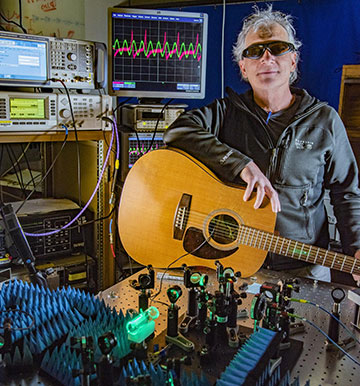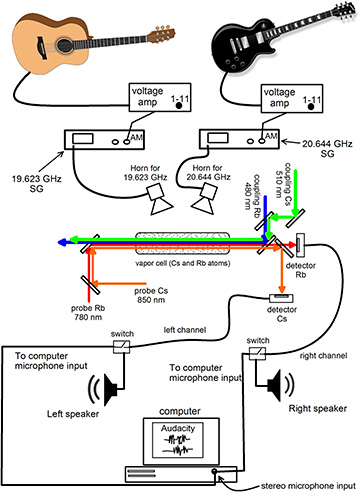
Christopher Holloway and colleagues at NIST in Boulder, Colo., USA, have used the principles of quantum mechanics to record guitar music using an atom vapor cell, lasers and electromagnetically induced transparency. [Image: J. Burrus at NIST]
Over the past half-decade, research labs have made progress in quantum sensors that use ensembles of Rydberg atoms to sense subtle changes in radio-frequency (RF) electric fields (E-fields). Now, scientists working on the problem at the U.S. National Institute of Standards and Technology (NIST) in Boulder, Colo., have offered a whimsical demo of just how far this research has come: they’ve used an atom vapor cell and some cleverly applied laser energy to serve as quantum audio-recording equipment (AIP Adv., doi: 10.1063/1.5099036). And they’ve got the guitar tracks to prove it.
Sensing radio fields with EIT
Rydberg atoms are excited atoms with one or more electrons kicked up to a very high principal quantum number. They’re particularly good candidates for sensing electromagnetic-field changes because of their extremely large electric dipole moments, which exaggerate their response to even small changes in external electric fields.
The NIST lab of Christopher Holloway is one of several research groups that have focused on one approach to building such E-field sensors, using the phenomenon of electromagnetically induced transparency (EIT). In this approach, a weak probe laser, tuned near the resonance of one of the atoms’ electronic transitions, is applied to a vapor cell of Rydberg atoms and measures the absorption spectrum at that transition. Then a stronger laser field, called the coupling field and tuned near the resonance of a different electronic transition, is shot through the vapor cell. The strong coupling laser field creates a “window of transparency” for the probe laser in a narrow spectral range around the transition, changing the absorption spectrum (and thus the transmission) of the probe beam through the vapor cell.
It turns out that, because of the extremely high sensitivity of Rydberg atoms to E-fields, an externally applied RF field will alter the state of the Rydberg atoms in such a vapor cell, and thus the EIT signal from the probe laser. This has allowed researchers to design alternative kinds of very sensitive, broadband radio antennas out of atomic vapor cells, with potential applications, among other things, in deep-space communication, according to Holloway.
An atom-vapor-cell recording studio
To put this framework to work as an audio recorder, Holloway and his team started with two guitars—an acoustic guitar with an electronic pickup and an electric guitar—and hooked them into two home-built amplifier and amplitude-modulation (AM) circuits. When the guitars were played, the output of the processing was two different AM carrier waves at different radio frequencies.
A schematic of the NIST team’s recording setup. [Image: C.L. Holloway et al., AIP Adv., doi: 10.1063/1.5099036; CC-BY 4.0] [Enlarge image]
Those AM carriers were then passed to two standard-gain horn antennas that were pointed to a vapor cell containing an atomic vapor of two different Rydberg atom species, 133Cs and 85Rb. The horn-antenna frequencies were such that the 133Cs were tuned to respond to the AM frequency for the acoustic guitar (19.623 GHz), while the 85Rb atoms received the AM signal from the electric guitar (20.644 GHz).
As the guitars were played, the vapor cell was exposed to laser fields from two different coupling-probe laser combinations, one tuned to Rydberg transitions in 133Cs and one tuned to transitions in 85Rb. The team measured the transmission of the probe lasers through the cell using two different photodetectors; the changes in transmission logged at the photodetector essentially recorded the changes in EIT induced by the AM radio signals from the guitars.
High-fidelity recordings
Because the photodetector output constitutes a voltage waveform directly related to the audio waveforms from the two guitars, the team was able simply to plug the output into computer speakers and play back the guitar tracks from the optical EIT output of the atom vapor cell, with no additional processing. They also plugged the photodetector output directly into the computer’s microphone input and used the open-source computer audio software Audacity to capture the guitar music as “recorded” by the atom vapor cell.
The team posted, alongside the paper, one of the recordings made using the method (including only a single acoustic guitar). While the recording made using EIT through a Rydberg atom vapor cell does include a bit of static, reminiscent of an old-school vinyl recording, it reproduces the guitar sound with remarkably high fidelity. And that is—there is no other word for it—really cool.
An “entertaining” example of quantum tech
Holloway and colleagues don’t expect their Rydberg atom vapor cell to replace modern digital recording techniques. Instead, they appear to intend the experiment to serve as an “entertaining” demonstration of quantum sensing to inspire future quantum scientists, by showing how “the sometimes esoteric field of quantum physics” can be applied in unexpected ways.
“It is quite amazing,” the researchers write, “that over the past decade we have learned to control ensembles of atoms to such an extent that they can be used to record waveforms.”

